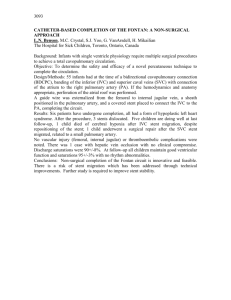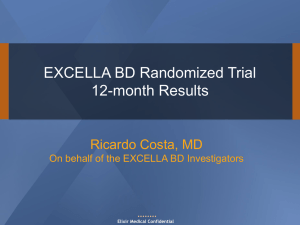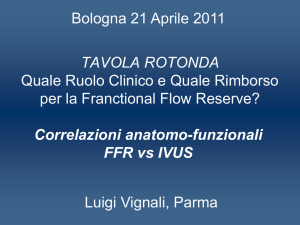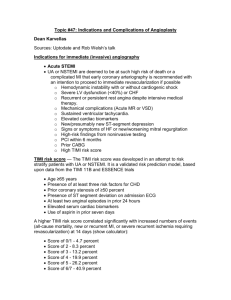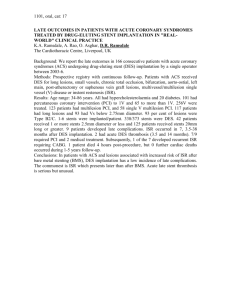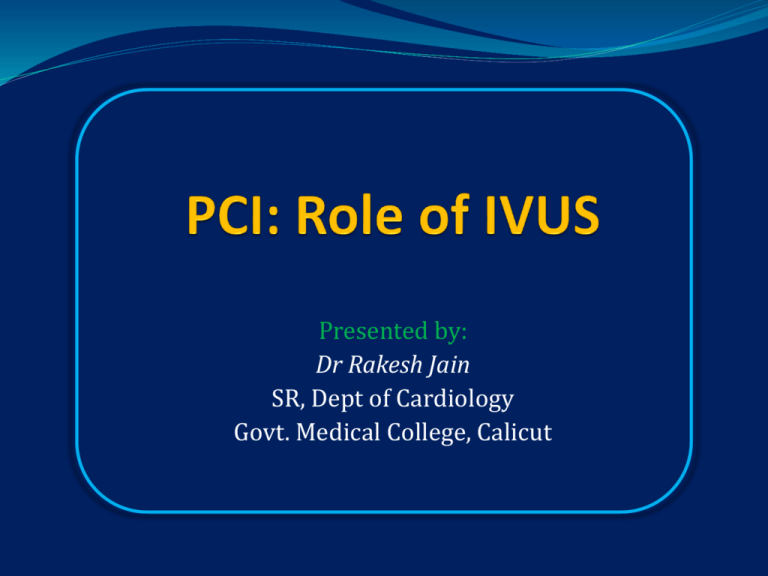
Presented by:
Dr Rakesh Jain
SR, Dept of Cardiology
Govt. Medical College, Calicut
BACKGROUND
Coronary angiogram remains “gold standard” method for
CAD.
Inherent pitfalls:
Fails to accurately determine anatomy
Luminogram (2-D representation of 3-D coronary lumen)
(eccentric diffuse coronary disease, lesion foreshortening, angulations,
calcification and vessel overlap )
During PCI, these results in:
Stent under expansion
Incomplete stent apposition
Incomplete lesion coverage
Hence, suboptimal stent deployment reported to be potent
IVUS predictors of stent restenosis and stent thrombosis.
Role of IVUS
To guide PCI with BMS
To guide PCI with DES
To guide PCI within ULMCA
IVUS guided CTO lesion
IVUS guided bifurcation lesion
Role of IVUS in SVG stenting
Assessment of angiographic intermediate lesion
Why IVUS guided stenting?
Reality of stenting procedures in daily practice
PCI has been the fastest growing method and coronary stents
currently used in >90% of PCI procedures.
Procedural success of PCI is usually determined by visual
estimation by the operator and angiographic success after PCI
is defined as the attainment of residual diameter stenosis of
<30% and relief of ischemia.
Such subjective estimation of the severity of coronary artery
stenosis is thought to be of limited reliability.
Post dilatation clinical comparative study
(POSTIT trial)
To assess
achievement of optimal stent deployment
(MSD≥90% of average reference lumen diameter on IVUS)
performed immediately post stent deployment.
256 patients
Early generation balloon expandable BMS with noncompliant
balloons to optimize stent deployment were used.
Frequency of optimum stent deployment (< 12 atm 14% vs. ≥
12 atm 36%; P = 0.007).
On postdilatation, frequency of achieving optimum stent
deployment increased to 42%.
Cathet Cardiovasc Intervent 2003;59:184–192
Another IVUS study…
To assess stent expansion depending on manufacturer’s
compliance chart as a guideline.
200 patients
Used early generation DES (>2.5 mm) without postdilatation.
Only 75% of DES obtained predicted minimal stent diameter
and 66% obtained predicted minimal stent area (MSA).
Showed that Compliance charts fail to predict final MSD and
MSA.
De Ribamar Costa J Jr . Et al. Am Heart J 2007;153:297-303
75% of DES obtained
predicted minimal
stent diameter
66% obtained
predicted minimal
stent area (MSA).
De Ribamar Costa J Jr . Et al. Am Heart J 2007;153:297-303
Thus,
Angiographic success cannot always be linked with optimal
stent expansion, despite higher pressure balloon inflation
during the stenting procedure.
In turn, stent optimization using a high pressure balloon
without IVUS guidance also has been associated with an
increased risk of edge dissection and arterial perforation.
Hence IVUS is a hope !!!
IVUS is better than contrast angiography in
Selecting adequate stent sizing
Defining post stent deployment dimensions
Confirming complete stent apposition and
Excluding edge dissections
i.e. confirming optimal stent deployment
All important procedural variables that may predispose
to both early and late complications including in-stent
restenosis & stent thrombosis.
EVIDENCES: IVUS guided PCI with BMS:
CRUISE trial (Can Routine Ultrasound Influence Stent Expansion)
2000
Multicenter, prospective, observational, IVUS substudy
525 pts (mean age 60±11yrs)
primary end point: postprocedure measure of minimal stent
dimensions by angiography (diameter) and by ultrasound
(area, minimal diameter)
Inclusion criteria: symptomatic IHD, new or restenotic lesions
of native coronary circulation, NO LMCA disease or MI ≤ 7 days.
IVUS guided group had a larger MLD (2.96±0.55 vs. 2.59±0.43,
p<0.001) and a larger minimal stent CSA (7.78±1.72 vs.
7.0±62.13 mm2, p<0.001).
At 9-months follow-up, TLR occurred significantly less
frequently in the IVUS guided group (8.5% vs. 15.3%, p<0.05)
with no significant difference in death and MI.
Fitzgerald PJ et al. Circulation 2000; 102: 523-30.
Example case for documentary (angiographically guided) stent implantation
group: 3.0 mm stent was implanted to address critical narrowing in mid LCX
3.0 mm stent was implanted to address critical narrowing in LCX. Despite
acceptable angiographic appearance (A), IVUS demonstrates underdeployment,
achieving MSA of only 5.61 mm2 (B) compared with proximal reference segment
of 10.40 mm2 (C).
Fitzgerald P et al. Circulation 2000;102:523-530
Copyright © American Heart Association, Inc. All rights reserved.
Example case for guided (both angiographically and IVUS-guided) stent
implantation group.
Angiogram after stent deployment in mid RCA with 3.5-mm balloon inflated at
16 atm shows acceptable result (A). Initial IVUS (B) shows underdeployment.
IVUS image after further dilatation with 4.0-mm balloon at 16 atm demonstrates
substantial improvement in MSA (C)
Fitzgerald P et al. Circulation 2000;102:523-530
Copyright © American Heart Association, Inc. All rights reserved.
Clinical outcomes at 9 months in both study groups.
Fitzgerald P et al. Circulation 2000;102:523-530
Copyright © American Heart Association, Inc. All rights reserved.
Balloon Equivalent to Stent (BEST) Study,2003
Noninferiority , multicenter, randomized study
Compared IVUS guided balloon angioplasty V/S systematic stenting
132 pts were randomized in IVUS guided balloon angioplasty and 122 in
stenting group (18 to 80 years). NO LMCA lesion or MI ≤3 days.
Results: Crossover to stent was needed in 58 patients (44%) because of
dissection (18%) or unsatisfactory result (26%).
Final MLD was larger in the stent group (2.75±0.49 vs. 2.55±0.49 mm with
aggressive PTCA p=0.013). also pts from aggressive PTCA group who crossed
over to stent had similar immediate results as those in stent group
(2.69±0.49 vs. 2.75±0.49 respectively p=0.65)
At 6-months, restenosis rate was 16.8±6.7% in the aggressive PTCA group
vs. 18.1±7.0% in the stent group (p=0.70).
Also angiographic MLD did not differ significantly between the study groups
(1.97±0.72 vs. 2.03±0.72 mm, PTCA and stent respectively, p=0.38)
Conclusion: Strategy of IVUS guided angioplasty with provisional stenting is
feasible and safe, it reduces stent rate by half with similar 6 month
angiographic, IVUS and clinical outcome.
Schiele F et al. Circulation 2003; 107: 545-51
Cumulative curves of angiographic MLD (top) and IVUS minimum L-CSA
(bottom) before (data on left of chart) and after (data on right) angioplasty and
at 6-month follow-up (data in middle) in the aggressive PTCA (▵) and stent (○)
groups.
18 to 80 years
Schiele F et al. Circulation 2003;107:545-551
Copyright © American Heart Association, Inc. All rights reserved.
Restenosis after IVUS guided Stenting (RESIST)
study, 1998
first randomized, multicenter, single blinded trial to investigate the
impact of IVUS guided PCI on outcome.
155 pts (10 females, mean age 56 yrs).
Results: IVUS guided stent dilation was not associated with a difference
in mean luminal diameter or average percent stenosis at 6 month follow
up.
6 month CSA was 5.36±2.81 mm2 in IVUS group and 4.47± 2.59 mm2 in
non-IVUS group (p=0.03).
Restenosis rate (>50% narrowing at the stent site) did not differ by
treatment group (22.5% in the IVUS group and 28.8% in the non-IVUS
group (p=0.25), nor did minimum lumen diameter (1.70 mm vs 1.60
mm, p=0.20).
Interpretation: Among patients with symptomatic CAD without recent
acute coronary syndrome (<7 days) IVUS-guided stent deployment was
not associated with significant differences in 6 month mean luminal
diameter but was associated with a significant increase in lumen cross
sectional area.
Schiele F et al. J Am Coll Cardiol.1998 Aug;32(2):320-8.
Optimization with Intracoronary Ultrasound to Reduce
Stent Restenosis (OPTICUS), 2001
Large multicenter, randomized study
550 patients were randomized to stent implantation with IVUS (n=5273) or
angiographic guidance (n=5275), mean age: 60±10 yrs, M:F= 1:1.
MUSIC study criteria were applied for optimal IVUS guided stent implantation
(achieved only in 56%).
Results: Six-months repeat angiography revealed no significant differences
between the groups with respect to binary restenosis rates (24.5% vs. 22.8%,
p=0.68) and MLD (1.95±0.72 vs. 1.91±0.68 mm, p=0.52) respectively in IVUS
and angiography guided groups.
At 12 months, neither MACE (relative risk [RR], 1.07; 95% CI 0.75-1.52;
p=0.71) nor repeat revascularization (RR 1.04; 95% CI 0.64 to 1.67; p=0.87)
were reduced in the IVUS-guided group.
authors concluded that the study does not support routine use of IVUS to
guide coronary stenting.
Mudra H et al. Circulation 2001; 104: 1343-9.
de Jaegere P et al.Eur Heart J 1998;19:1214 –23.
Thrombocyte Activity Evaluation and Effects of Ultrasound
Guidance in Long Intracoronary Stent Placement (TULIP), 2005
Multicenter, randomized trial
IVUS (n=73) or angiographic guidance (n=71).
Pts with long lesions (≥20 mm) that permitted a stent diameter ≥3 mm were
analyzed
IVUS optimization criteria 1) complete stent apposition 2) MLD≥ 80% of the mean
of prox and distal reference diameters 3) MLA≥ distal reference lumen area.
(Criteria achieved in 89% ).
Results: At 6 months, MLD in IVUS group (1.82±0.53 mm) was larger than in
angiography group (1.51±0.71 mm; p=0.042).
TLR and combined end point were 4% and 6% in the IVUS group and 14% and
20% in angiography group respectively (p=0.037 for TLR and p=0.01 for combined
events).
Restenosis (>50% diameter stenosis) was found in 23% of IVUS group and 45% of
angiography group (P=0.008).
At 12 months, TLR and the combined end point occurred in 10% and 12% of
IVUS group and 23% and 27% of the angiography group (p=0.018 and p=0.026)
respectively.
Conclusions: Angiographic and clinical outcome up to 12 months after long stent
placement guided by IVUS is superior to guidance by angiography.
Oemrawsingh P et al. Circulation 2003;107:62-67
Cumulative distribution of MLD. Pre indicates before intervention; Post, after
intervention; and FU, follow-up.
Oemrawsingh P et al. Circulation 2003;107:62-67
Copyright © American Heart Association, Inc. All rights reserved.
Kaplan-Meier survival curves
Oemrawsingh P et al. Circulation 2003;107:62-67
Copyright © American Heart Association, Inc. All rights reserved.
The Angiography Versus Intravascular Ultrasound- Directed
(AVID), 2009
Largest multicenter randomized study
To assess effect of IVUS directed stent placement on 12 month rate of TLR.
After elective coronary stent placement and optimal angiographic result
(<10% stenosis), 800 patients were randomized to angiography or IVUS
directed therapy.
IVUS criteria for optimal stent placement (<10% area stenosis, apposition
and absence of dissection) (Criteria accomplished only in 48% patients).
Results: Final minimum stent area was 6.90±2.43 mm2 in the angiography
group and 7.55±2.82 mm2 in IVUS group (p=0.001).
12 month TLR rate was 12.0% in angiography and 8.1% in IVUS group
(p=0.08) {When vessels with a distal reference diameter <2.5 mm were
excluded from analysis, TLR rate was 10.1% in angiography group and 4.3%
in IVUS group p=0.01}.
Conclusions: IVUS directed bare metal stent placement results in larger
acute stent dimensions without an increase in complications and a
significantly lower 12 month TLR rate for vessels ≥2.5 mm by angiography
and for vessels with high-grade prestent stenosis.
Russo R et al. Circ Cardiovasc Interv 2009;2:113-123
Subgroup analyses of 12 month TLR rates by distal reference vessel diameter (A) which
demonstrates a significant clinical benefit in vessels ≥2.5 mm; by vessel treated (B); and by prestent
% diameter stenosis (C) with a significant improvement in IVUS-directed group in patients with a
high-grade prestent lesion severity.
Russo R et al. Circ Cardiovasc Interv 2009;2:113-123
Copyright © American Heart Association, Inc. All rights reserved.
IVUS-Guided DES
Following the introduction of DES into clinical practice, restenosis rates
have been dramatically reduced but increasing use of DES in complex
lesions has led to significantly higher rates of DES restenosis with TLR
rates reach 10% at 2 yrs follow up.
Other big issue remains of stent thrombosis(ST) !!!
Causes implicated:
Stent under expansion
Incomplete stent apposition
Edge dissections
Delayed endothelialization
IVUS guidance has therefore been advocated as a possible solution to
optimize the results of stenting and theoretically reduce the risk of ST,
in addition to improving restenosis rates and consequently the need for
repeated revascularization.
Marzocchi A. et al. REAL multicenter registry. Circulation 2007;115:3181—8.
The potential clinical utility of intravascular ultrasound guidance
in patients undergoing percutaneous coronary intervention with
drug eluting stents
To assess whether IVUS guided PCI with DES yields clinical
benefit in terms of stent thrombosis and major adverse cardiac
events (MACE).
1768 pts included from Washington Hospital Center.
Primary endpoint: definite stent thrombosis at 12 mths.
Secondary endpoint was: MACE.
Patients undergoing IVUS guided DES implantation underwent
less direct stenting, more post dilation and had greater cutting
balloon and rotational atherectomy use.
Roy et al .European Heart Journal (2008) 29, 1851–1857
Results: At 30 days and at 12 months, a higher rate of definite stent
thrombosis was seen in No IVUS group (0.5 vs. 1.4%; p = 0.046) and
(0.7 vs. 2.0%; P = 0.014) respectively.
No major differences in MACE (14.5 vs. 16.2%; p = 0.33) at 12
month follow up between the groups.
Rates of death and Q wave MI were similar.
However, a trend was seen in favour of IVUS group in target lesion
revascularization (5.1 vs. 7.2%; p =0.07).
Conclusion: IVUS guidance during DES implantation has the
potential to influence treatment strategy and reduce both DES
thrombosis and the need for repeat revascularization.
Roy et al .European Heart Journal (2008) 29, 1851–1857
Long-term health outcome and mortality evaluation after invasive coronary
treatment using drug eluting stents with or without the IVUS guidance.
Randomized control trial. (HOME DES IVUS) 2010: Randomized trial
To assess role of IVUS during implantation of DES on long term outcome
in pts with complex coronary artery disease and high clinical risk
profile with special attention to the development of late stent
thrombosis (LST).
210 pts were randomly assigned to receive DES either with (N = 105) or
without (N = 105) IVUS guidance.
Dual antiplatelet treatment was administered for 6 months in all
patients.
Results: At 18 month follow up, no significant difference between both
groups regarding MACE (11% vs. 12%; p= NS).
Stent thrombosis has occurred 3.8% in the group with and 5.7% (p=
NS) in the group without the IVUS guidance.
Conclusion: study failed to demonstrate the superiority of the IVUS
guidance during DES implantation over standard high pressure
postdilatation.
Catheter Cardiovasc Interv. 2010 Mar 1;75(4):578-83
A prospective, randomized trial of intravascular-ultrasound guided compared to
angiography guided stent implantation in complex coronary lesions:
(The AVIO trial), 2013
Randomized, multicentre, international, open label, investigator driven
study, n=284 patients.
Aim was to evaluate if IVUS optimized DES implantation was superior
to angiographic guidance alone in complex lesions.
Complex lesions were defined as one of the following:
Long lesions (>28 mm)
CTO: total occlusion of duration >3 mths
Lesions involving a bifurcation
Small vessels ≤2.5mm
Patients requiring 4 or more stents
Primary study endpoint: post procedure in lesion minimal lumen
diameter.
All patients were pretreated with ticlopidine or clopidogrel plus Aspirin
& loading dose of 300 mg of clopidogrel if required.
The Optimal balloon size was determined by averaging the media to
media diameters of distal and proximal stent segments as well as at the
sites of maximal narrowing within the stent.
Alaide Chieffo et al. Am Heart J 2013;165:65-72
AVIO criteria for optimal stent expansion
Most of the lesions included were
Long lesions: 62.1% in IVUS vs. 58.0% in angiography guided group.
Bifurcation lesions respectively in 23.1% vs. 27.2% .
Small vessels in 21.9% vs 23.7%.
CTOs were present in 13.6% in IVUS vs 17.8% in angiography guided group.
Postdilatation was most frequently performed to the lesions treated in the
IVUS group (88.3% vs 68.4%; p= .0001).
de Jaegere P et al.Eur Heart J 1998;19:1214 –23.
Results: Primary study end point showed a statistically significant
difference in favor of IVUS group (2.70 mm ± 0.46 mm vs. 2.51 ± 0.46mm;
p = .0002).
During hospitalization, no patient died, had repeated revascularization or
a Q wave MI.
No difference was observed in occurrence of non-Q wave MI (6.3% in IVUS
vs. 7.0% in angio guided group)
At 24 months clinical follow up, no differences were still observed in
cumulative MACE (16.9%vs. 23.2 %), cardiac death (0% vs 1.4%), MI
(7.0% vs. 8.5%), target lesion revascularization (9.2% vs. 11.9%) or target
vessel revascularization (9.8% vs. 15.5%) respectively in the IVUS vs angio
guided groups.
In total, only one definite subacute stent thrombosis occurred in the IVUS
group.
Conclusion: A benefit of IVUS optimized DES implantation was observed in
complex lesions in the post procedure minimal lumen diameter. No
statistically significant difference was found in MACE up to 24 months.
AVIO trial: Primary study end point. Baseline and final MLD in angiography as compared
to IVUS guided
Alaide Chieffo et al. Am Heart J 2013;165:65-72
Impact of intravascular ultrasound-guided percutaneous coronary
intervention on long-term clinical outcomes in a real world
population, 2013
To compare long term clinical outcomes between IVUS guided and angiography
guided PCI in large "real world" registry.
Between1998 -2006, 8371 pts who underwent IVUS (n = 4,627) or angiography (n =
3,744) guided PCI were enrolled with 3 yrs of follow up.
Results: 3 year mortality rate was significantly lower in IVUS guided group than in
angiography guided group (96.4% ± 0.3% vs. 93.6% ± 0.4%, p < 0.001)
Similarly, in DES population, 3 year mortality was significantly lower in IVUS guided
PCI (HR 0.46; 95% CI 0.33-0.66, p < 0.001) group.
In contrast, IVUS guided PCI did not reduce the risk of mortality in the bare metal
stent population (HR 0.82; 95% CI 0.60-1.10, p = 0.185).
However, risks of MI(HR 0.95; 95% CI 0.63-1.44, P = 0.810), TVR (HR 1.00; 95% CI
0.86-1.15, p = 0.944), and stent thrombosis (HR 0.82; 95% CI 0.53-1.07, p = 0.109)
were not associated with IVUS guidance.
Conclusion: IVUS guided PCI may reduce long term mortality when compared with
conventional angiography guided PCI. This may encourage the routine use of IVUS for
PCI in patients undergoing DES implantation.
Hur SH et al Catheter Cardiovasc Interv,2013 Feb;81(3):407-16
Percutaneous interventional approach for unprotected left main
coronary artery (LMCA)
Angiography has limitations in assessing lesion morphology and true luminal size
particularly of LMCA because of:
Aortic cusp opacification
Streaming of contrast agent,
Short vessel length
Lack of a normal reference segment
Overlapping daughter branches
Because of these, correct physiological lesion classification by even experienced
interventional cardiologists occurs in no >50% of occasions with large
interobserver variabilities.
Lindstaedt M et al Int J Cardiol 2007;120:254–61
There is no other segment within the human coronary vasculature that is subject to
such a significant degree of interobserver variability when assessing the degree of
lumen compromise.
Therefore
IVUS assessment before the procedure can not only detect significant stenosis but
can also select the appropriate diameter and length of the stent, hence is very
helpful in optimally expanding the stent.
Sano K, et al . Am Heart J. 2007;154:983–988
MAIN-COMPARE (Revascularization for Unprotected Left Main Coronary
Artery Stenosis: Comparison of Percutaneous Coronary Angioplasty Versus
Surgical Revascularization) trial, 2011
Patients with unprotected LMCA stenosis underwent elective stenting under
guidance of IVUS (756 patients) or conventional angiography (219 pts).
Acute myocardial infarction were excluded.
Results: In 201 matched pairs of overall population, there was a tendency of
lower risk of 3 year morality with IVUS guidance compared with
angiography guidance (6.0% versus 13.6%, p=0.063)
In 145 matched pairs of patients receiving DES, 3 year incidence of
mortality was lower with IVUS guidance as compared with angiography
guidance (4.7% versus 16.0%, P=0.048).
Use of IVUS guidance did not reduce the risk of mortality in 47 matched
pairs of pts receiving BMS (8.6% versus 10.8%, p=0.35).
Risk of MI or target vessel revascularization was not associated with use of
IVUS guidance.
Conclusions: Elective stenting with IVUS guidance especially in the
placement of DES may reduce the long term mortality rate for unprotected
LMCA stenosis when compared with conventional angiography guidance.
Kim JS et al. Circ Cardiovasc Interv. 2009;2:167-177
Kaplan-Meier incidence curves of outcomes following IVUS and angiography
guidances in 201 propensity matched pairs of the overall population.
Park S et al. Circ Cardiovasc Interv 2009;2:167-177
Copyright © American Heart Association, Inc. All rights reserved.
IVUS guided PCI in bifurcation lesions data from Korean
multicenter bifurcation registry
Aim: To investigate impact of IVUS guided DES implantation on long
term clinical outcomes in bifurcation lesions.
1,668 patients with non-left main de novo bifurcation lesions (2004-
2006) were screened (487 pts in IVUS guidance and 487 in angiography
guidance were selected).
Results: Maximal stent diameters at MB and SB were larger in the IVUS
guided group.
Incidence of death or MI was significantly lower in IVUS guided group
compared to angiography guided group (3.8% vs 7.8%, p = .03).
Conclusion: IVUS guidance during DES implantation in bifurcation
lesions may be helpful to improve long term clinical outcomes by
reducing the occurrence of death or MI.
Kim JS. Am Heart J. 2011 Jan;161(1):180-7
Effect of intravascular ultrasound findings on long-term repeat revascularization in
patients undergoing drug eluting stent implantation for severe unprotected left
main bifurcation narrowing
Using LAD pullback, ostial LAD artery (3 mm distal to carina), polygon of
confluence (POC: confluent zone of LAD artery and left circumflex artery) and
distal LM artery (3 mm just proximal to POC) was evaluated for MLA and minimum
stent area within each segment.
In 168 LM bifurcations, preprocedural MLA and post stenting minimum stent area
were located within LM artery and within the POC in 41% and 70% respectively.
Results: Independent predictors for post stent minimum stent area within the
distal portion of LM artery above LAD carina were the preprocedural lumen area of
LAD carina (p = 0.001) and preprocedural MLA within the POC (p = 0.008)
During 41.8 ± 18.0 month follow up period, 26 patients experienced cardiac
events.
Female gender (p = 0.018) and preprocedural MLA within the POC (p = 0.020)
were independent predictors for the occurrence of events at 3 years of follow up.
Conclusion: Preprocedural MLA within the POC was a surrogate reflecting overall
severity of LM bifurcation disease, contributed to the post stent minimum stent
area within the distal segment of LM bifurcation and was a predictor of clinical
events during follow up.
Kang S J et al. Am J Cardiol. 2011 Feb 1;107(3):367-73
2011 General Consensus on LMCA Bifurcation Lesion
For distal/bifurcation ULMCA lesions, every effort should
be made to achieve the greatest possible lumen dimensions
before stent deployment and post dilation should be
performed to achieve a minimum stent area of
LMCA lesion >8.5 mm2,
origin LAD> 5.5 mm2 and
origin LCX >5.5 mm2
Leon MB et al. 8th Annual Chronic Total Occlusion and Left Main
Coronary Intervention Summit, February 2011, New York, NY
IVUS guided PCI in CTO
• First series involves 31 patients, with 22 patients having previous failed
attempts at CTO recanalization.
• All patients were treated with bilateral approach and using IVUS-guided
reverse CART concept.
Results: Successful recanalization of the CTO was achieved in all cases
(100%).
Access route was septal collateral in 20 (70%) cases and epicardial
collateral in 11 (30%) cases.
IVUS guidance was used successfully in 30 cases and the channel
dilator (microcatheter) was used in 27 cases.
Guidewire injury and grade 1 perforation was seen in 3 (9%) cases,
which were managed conservatively.
There was no death, CABG or pericardiocentesis in this group of
patients.
Mean fluoroscopy time was 65.84 ±23.16 min ranging from 31 to 106
min and total contrast volume used 321.32 ±137.77 ml (range 115 to
650 ml).
Conclusion: First series describes a high success rate of CTO
recanalization with IVUS guided reverse CART in selected patients
performed by an experienced operator.
IVC guided PCI in SVG:
Outcome of undersized drug-eluting stents for percutaneous coronary intervention
of saphenous vein graft lesions
To determine outcome with undersized DES for PCI of SVG lesions.
Using IVS, 209 SVG lesions were treated with DES(153 SES and 56 PES).
Lesions were divided into 3 groups according to the ratio of stent
diameter to average IVUS reference lumen diameter: group I <0.89;
group II 0.9 to 1.0; and group III >1.0.
Results: Incidence of CK-MB elevation >3 times normal was 6% in
group I, 9% in group II and 19% in group III (p = 0.025).
No significant differences were found in incidence of TLR (group
I=13%; group II=9%; and group III=15%; p = 0.5) or target vessel
revascularization (group I= 13%; group II=13%; and group III= 15%; p
= 0.9) among the 3 groups.
Conclusion: Use of undersized DES to treat SVG lesions is associated
with a reduction in frequency of post PCI CK-MB elevation without an
increase in 1 year events.
Yong YJ et al. Am J Cardiol. 2010 Jan 15;105(2):179-85
Role of IVUS in management of angiographic intermediate
lesion (40-70% stenosis)
Remains a therapeutic dilemma, even for experienced
interventional cardiologists.
Fractional flow reserve (FFR) is considered the gold standard
for intermediate lesion assessment.
Several studies have reported fairly good correlation between
anatomic data by IVUS and ischemia by physiological
assessments, hence FFR can be accurately predicted.
Non left main lesion
53 intermediate lesions in 43 pts.
Cut-off value of an MLA <4mm2 also correlated moderately
well with an FFR <0.75 with a sensitivity and specificity of
92% and 56% respectively.
Briguori C, Am J Cardiol 2001;87:136–41
Low event rates were noted in 300 pts with intermediate
lesions in whom intervention was deferred for an IVUS MLA
≥4 mm2
Abizaid AS, Circulation 1999;100:256–61
Evidences for IVUS-MLA & FFR
236 intermediate lesions from 201 patients were included.
Best cut-off value of MLA to predict an FFR <0.80 was 2.4mm2
(sensitivity of 90% and specificity of 60%).
Kang SJ. Circ Cardiovasc Interv 2011;4:65–71.
92 intermediate lesions from 84 patients, MLA of <2.8 mm2
and < 3.2 mm2 best correlated with an FFR < 0.75 and < 0.80
respectively.
Ben-Dor Euro Intervention 2011;7:225–33 94
Pts with intermediate lesions with smaller vessel (reference
diameter <3.0 mm), the best predictors for FFR <0.75 were
MLA <2.0 mm2 (sensitivity of 82% and specificity of 81%).
Lee CH et al. Am J Cardiol 2010;105:1378–84.
IVUS criteria for a “significant” Non-LMCA stenosis
J A C C : C A R D I O V A S C U L A R I N T E R V E N T I O N S , V O L . 4 , N O . 1 1 , 2 0 1 1 McDaniel et al.
NOVEMBER2011:1155–67
Left main intermediate lesions (30-60% stenosis)
55 pts with moderate left main stenosis, an MLA
Cut-off value of 5.9 mm2 (sensitivity of 93% and specificity of
95%) and a minimal lumen diameter of <2.8 mm (sensitivity
of 93% and specificity of 98%) best correlated with FFR
<0.75.
Jasti V, Circulation 2004;110:2831– 6.
354 patients with intermediate left main stenoses, an MLA
value >6.0 mm2 identified patients at low risk for adverse
events with deferred revascularization.
de la Torre Hernandez. J Am Coll Cardiol 2011;58:351– 8
FFR should be the preferred modality for intermediate
left main lesion assessment
However, if IVUS is used
Revascularization may be deferred in patients with left
main MLA ≥ 6.0 mm2.
For an MLA <6.0 mm2, consideration should be given to
performing FFR or noninvasive stress testing before
revascularization.
Rishi puri et al. J Am Coll Cardiol Intv 2012;5:697-707
IVUS criteria for a “significant” LMCA stenosis
2011 ACCF/AHA/SCAI PCI Guideline
IVUS: Recommendations
CLASS IIa
1. IVUS is reasonable for the assessment of angiographically indeterminant left main CAD.
(Level of Evidence: B)
2. IVUS and coronary angiography are reasonable 4 to 6 weeks and 1 year after cardiac
transplantation to exclude donor CAD, detect rapidly progressive cardiac allograft
vasculopathy and provide prognostic information. (Level of Evidence: B)
3. IVUS is reasonable to determine the mechanism of stent restenosis (Level of Evidence: C)
CLASS IIb
1. IVUS may be reasonable for the assessment of non–left main coronary arteries with
angiographically intermediate coronary stenoses (50% to 70% diameter stenosis). (Level
of Evidence: B)
2. IVUS may be considered for guidance of coronary stent implantation, particularly in cases
of left main coronary artery stenting (Level of Evidence: B)
3. IVUS may be reasonable to determine the mechanism of stent thrombosis. (Level of
Evidence: C)
CLASS III: NO BENEFIT
1. IVUS for routine lesion assessment is not recommended when revascularization with PCI
or CABG is not being contemplated. (Level of Evidence: C)
Levine et al. JACC Vol. 58, No. 24, 2011



